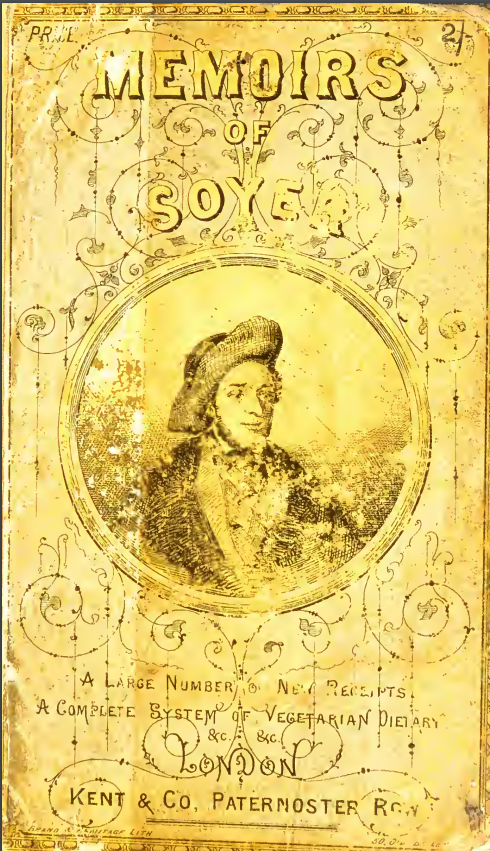
11 Aug The Memoirs of Alexis Soyer. By F.R Volant & J. Warren.

Facsimile of Memoirs of Alexis Soyer
The Memoirs of Alexis Soyer.
Compiled and Edited by F. Volant & J R Warren His late secretaries And Esteemed friend J G Lomax.
If we look at the claim that Lomax is an esteemed friend this is simply not the case. Lomax started working for Alexis in the latter part of 1854, as his secretary. When Soyer decided to go to the Crimea in February 1855. He had assumed that Lomax would go with him, Lomax refused and this caused Alexis considerable delay in finding someone to replace him. He even asked George Augustus Sala. Who tells us in his book ‘The life and adventures of George Augustus Sala’ that he used to take care of all of Alexis’ correspondence in 1851 In the end, he found a Thomas Garfield to accompany him to the Crimea. Lomax was never his friend and only knew Alexis for three months.
James Warren was once a cook in the Reform Club under Alexis, he also attended Alexis’ funeral. Alexis used to have a close friend called George Warriner who worked for Alexis at the Reform Club, who also exhibited Alexis’ Osmazone soup at the Great Exhibition of 1851. Helped promote Alexis’ magic stove and went to the Crimea as one of Alexis’ staff. But I cannot find any information about Warren, if he did work for Alexis it would have to be between 1852 and 1854.
In regard to Francois Volant, I have discovered quite a lot. He worked for Alexis between 1842 and 1851. I would refer to him as more companion in arms than a secretary, he referred to himself as a translator. In ‘Memoirs’ he refers to himself as F——– V——- He tells us that on Emma Soyer’s death he went to Belgium to tell Soyer of his wife’s death. Soyer was staying at Francois Simonau’s nephew, Gustave Simonau’s house. There is credence to this story as I found Soyer’s and Volant’s arrival back into Britain on 3rd September 1842 on Princess Victoria out of Antwerp.
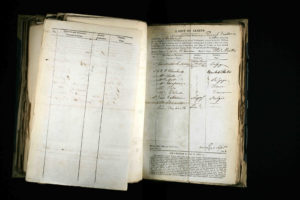
Soyer returning to England on the death of his wife Elizabeth.1842 SS Princess Victoria arrived from Antwerp 3rd September 1842.
Volant had the need to tell the readers of his book that Alexis could not write or read English. Alexis was a proud man and would not want this known. Volant tells us that after the death of Emma he employed a writing-master, but, to no avail as he could only master his signature. Alexis had no need to write in English before the Reform Club however he had to list the daily menu and bills of fare. Emma until her death use to do this for Alexis, also handle all his correspondence. So why did Volant tell us this – was it because he wanted everyone to know that he was the voice of Alexis until he left Alexis’ employ in disgrace. I have one letter written by Alexis in French. A French academic claimed it was a peasant hand, an ignorant hand. This cannot be surprising as Alexis only had about a year of scholarly education. In 1862 Warren & Volant publish another book titled ‘The Economy of Cookery for the Middle Class, The Tradesman and the Artizan’ the front cover has a chef and written on his apron they now call themselves ‘assistants to the Late Alexis Soyer’. Inside the book, they declare in the introduction ‘our long study of cookery in connection with the late Alexis Soyer.’ So, in three years they have gone from secretaries to cooks!!! However, I was very surprised that in their book they state that all three of them attended Alexis Soyer’s funeral, which was held at Kensal Green Cemetary on 11th August 1858. But, this was confirmed by The Era Newspaper which was published 15th August 1858. The list of attendees in ‘Memoirs’ wherein the exact same order as in The Era.
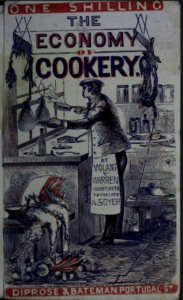
Volant & Warren’s 1862 Economy of Cooking.
In the first few pages of ‘Memoirs’ mistakes are made by these gentlemen authors who knew Alexis so well!! [I have included Helen Morris’ tome ‘A Portrait of a Chef’ as on rereading it for this post I have noticed quite a few inaccuracies not found in ‘Memoirs’]. They tell us that Alexis was born in October 1809, Helen Morris in ‘A Portrait of a Chef’ compounded the error by claiming it was 14th October 1809. When in fact Alexis was born 4th February 1810, I was the first person to publish that date with my book and my first website www.soyer.co.uk. I was handed the information by Elizabeth Ray who in turn had been sent an A4 sheet of paper written on it in French was copied an entry of Alexis’ true date of birth and below that was the English translation. Elizabeth was sent this after her own book was published. My ex-wife was in France at the time. So, I asked her to go to Meaux archives and find the entry – which she did, see the attached image. Now all French Actes up to 1900, are all available free online. Another glaring mistake they tell is the story that Alexis was in the cathedral choir and was hoping to join the seminary. Some authors have tried to research the seminary archives. However, the Soyers were Huguenots, French Protestants and the only cathedral in Meaux was Cathédrale Saint Ětienne de Meaux which was Catholic. So, no way is this account true. Later in ‘Memoirs,’ They claimed he visited Meaux, but why would he, His father Emery died 20 August 1818 in Conde Saint Libiare, when Alexis was 8 years old. His mother remarried to Pierre Philip Nicolas Travets on 22nd June 1819 in Crecy la Chapelle. She was living there when her son and Alexis’ brother, Philippe Alexis Nicolas Soyer died there on 27th March 1839 and when her husband, Pierre died there on 19th May 1843. So that contradicts that statement of Alexis going to Meaux in 1857, also when writing about Soyer’s Philanthropic Gallery, they mention that one of the pictures on display was called ‘A Farmer’s Wife’ and claimed it was a portrait of Alexis’ mother painted by Emma while she was in Meaux. A hard thing to do as Marie, Alexis’ mother was living in Crecy la Chapelle during most of Emma’s lifetime.

This is Alexis Soyer’s Naissance Acte that was issued in Meaux, France recording his birth at 10 pm on Sunday 4th, February 1810.
Volant tells us that in 1846 Alexis published the Gastronomic Regenerator. He claimed a kitchen-maid and an apprentice would watch how Alexis prepared a receipt and write it down. That may be so. But they certainly did not write the main body of the text. The author wrote of Milton and Paradise Lost. I believe Alexis dictated the text to Volant who wrote it down. In the first edition, the October 1809 as Alexis’ birth is written. But in Emma Soyer’s biography at the end of the book, the author claims she got married in 1836. This date was corrected to 12th April 1837 in ‘Memoirs,’ But the book claims that marrying on the same day was the Marquis of Douro, son of the Duke of Wellington. This is wrong or the authors were simply confused, the Marquis of Douro married Lady Elizabeth Hay 18th April 1839. Who got married the same day was Wellington’s nephew, Lord Marcus Hill, to Louisa Blake. Lord Marcus Hill – later was 3rd Baron Sandys. Who was chairman of the Reform Club committee, and was quite important to Alexis’ career at the Reform Club.

Marriage between Alexis Soyer and Emma Jones. Also shows the marriage of Lord Marcus Hill. The Duke of Wellington’s signature can be seen.
Another erroneous fact that ‘Memoirs’ claimed was that Emma Soyer eager to get her talent recognized, that in 1840 badgered the Royal Academy to exhibit one of her portraits, which was denied according to ‘Memoirs’. They claimed Emma asked Alexis to exploit his fame and write to the president of the Royal Academy Sir Martin Archer Shee who was president from 1830-45. Memoirs’ wrote that Emma and Alexis were not used to the rules of procedure at the Royal Academy. This story is so demeaning to Emma and Alexis. As far as I know, Emma Jones has the title of the youngest person to exhibit at the Royal Academy, which was Watercress Woman submitted in 1823 when Emma was 10 years old, she had 10 paintings exhibited until she got married in 1837. In 1840 she exhibited Juvenile Anglers and in 1842, the year of her death she exhibited Sir George Chetwynd. Hardly the results of someone who did not know the rules of procedure of the Royal Academy.
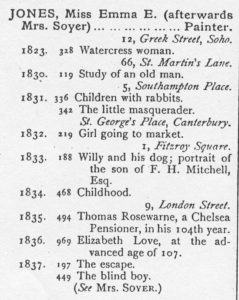
Extract taken from the list of Royal Academy Exhibitors showing Emma Jones entries from 1823.
The second slight on Alexis reputation, according to ‘Memoirs’ in the latter part of 1849. In the office of Soyer & Co, a Frenchman named Chevalier Lemolt (note no Christen name) who showed Alexis his miniature stove, 6” high and heated by spirit. ‘Memoirs’ then claimed that Alexis was so taken with the stove that he copied it and then called it Soyer’s magic stove and started to market it in 1850. However, nowhere in any newspapers or law courts did Chevalier Lemolt protest or tried to get a share of the revenue. In the later part of December 1851 until February 1852 appeared 6 advertisements in The Morning Post, which were titled ‘A New System of Electricity’ and had been awarded a gold medal in the Royal Academy, Paris. The person who was awarded the Gold Medal was a Chevalier Lemolt who arrived in England the latter part of 1851. There is no mention of a small stove alongside the description that ‘Memoirs’ gave. This was simply a very spiteful story by Francois Volant who used the name in an obscure advertisement to blacken Alexis reputation by suggesting that Alexis and his partner Alexandra Symons had stolen the design of the magic Stove. What Volant did not know that Alexis Soyer and Alexandra Symons under the name of Soyer & Co had submitted and registered two designs for the magic stove 29th August 1849 (patent number 2018) and 25th February 1850 (patent number 2202).

29th August 1849 number 2018, Design Registration for The Magic Stove
In 1851 in partnership with Joseph Feeny Alexis opened the Universal Symposium at Gore House, it was a wonderful affair [see my post about it] it cost a fortune to set up and Alexis was spending money wildly. Joseph Feeny concerned about his wealth asked Alexis if he could break their partnership. (According to Perry’s Bankrupt & Insolvent Gazette this took place 3rd July 1851). Alexis agreed and he asked his partner at Soyer & Co. Alexandra Symons to replace Feeny. Symons agreed. However, the venture ran out of money and Alexis closed it down. David Hart took over the lease and the debts 22nd November 1851. Soyer faced several court cases about money owing. One of the plaintiffs was Francois Volant. Alexis has employed him as a clerk and manager, he and Symonds did not see eye to eye, and Symonds thought Volant was acting above his station. On 1st December 1851 Volant appeared in court versus Symons and Soyer, suing them for the sum of £2. 7s. Alexis pleaded by default, but Symons wanted to defend the action. He claimed that the house had been closed in October and David Hart of Lemon Hart Rum had taken over the lease and debts of the Symposium and that Volant should make his case against Hart. The judge wanted to see Hart’s deed to see if Symon’s claim was correct. Hart’s solicitor refused to show it and claimed that the deed had nothing to do with the present case. This actually became a point of law and in a later court case brought by Volant, the judge agreed that Hart’s solicitor was correct. Volant was now suing for £54. 18s, again Alexis pleaded by default. But Symonds produced a receipt allegedly signed by Volant saying that he had signed for all the money up to date.
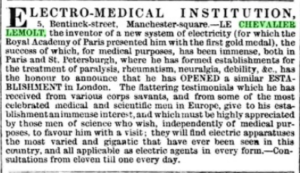
Advertisement in Morning Post 2 February 1852. Showing Chevalier Lemolt and his New System of Electricity.
Volant denied that was the case and the receipt was a forgery and the words ‘up to date’ had been added in another hand. The jury agreed. The judge told Volant that he was impounding the receipt because they might want to act against the defendants for fraud or forgery. But he did find for Volant the sum of £54 18s. it looks like François Volant wanted to take the case further and according to The Times newspaper. He was back in court on 14th January 1853, this was a strange case because Alexis now appeared as a witness for Volant. However this time the judge Mr Maude decided that much more had been made of the case and ordered that the receipt should dis-impounded. The other two judges agreed. I would assume Volant lost all his money in legal costs. Later in the year, Volant brought some space in the Times. He did not realize that he was doing damage to Soyer’s reputation, he thought his case was just between him and Alexandra Symons. Alexis accepted his argument [Soyer and Volant worked together on The Pantropheon so he knew Alexis was not the true author.] and shortly after the court case in January, Soyer and Symons disbanded their partnership in A. Soyer & Co. Symons was replaced by David Hart owner of Lemon Hart Rum Limited, which Alexis Soyer would come to regret.
Because of later research, I find that ‘Memoirs of Alexis Soyer’ also exaggerated another subject and that is Alexis being a Freemason on pages 283/284 of their tome They claim Alexis was of the higher degree, they mention all the degrees from 14 to 18 degree. The last that he was a Sovereign Prince Rose Croix of Heredom. This would have taken Alexis Soyer several years to achieve. Surprising that the authors mention all his degree titles, but not the lodge he attended. Yes. Alexis Soyer was a Freemason; however, he was only one for a year. His attended Robert Burns Lodge 25 at Freemasons’ Tavern, Great Queen Street, Holborn, London. This lodge was one of 47 in London at the time. According to the records for the lodge, Alexis joined in 1849 and left in 1850 when he left The Reform Club.



Sorry, the comment form is closed at this time.